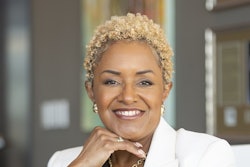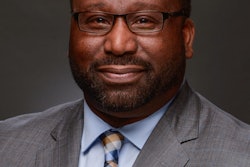NEW YORK – After Hamissou Samari’s mother passed away in Togo, he immigrated to the United States at age 23 with big dreams but never imagined he would be accepted to an institution like Harvard University.
“For me it was totally unrealistic to even think about it,” says the former shoe salesman. His parents were illiterate, and his father passed away three weeks shy of Samari’s seventh birthday.
The infinite possibilities for his life became apparent five years ago after Samari, then a student at the Borough of Manhattan Community College, was accepted into a Kaplan Educational Foundation scholarship and leadership program for nontraditional students enrolled in community colleges. Last year, Samari graduated from American University with a bachelor’s in international studies, and this fall he starts work on his master’s in public policy at Harvard.
“This drive, this determination I got is because of Kaplan,” says Samari. “Kaplan told me there is nothing that I want to do that I won’t be able to do.”
His introduction to Kaplan came when his community college adviser recommended Samari, who was excelling in his studies, for the Kaplan Educational Foundation’s Leadership Program. He along with three other students formed the program’s first cohort five years ago.
“If you’re an adult learner or you’re in community college, there’s not a lot of charitable support and yet those students tend to be tremendously needy,” says foundation chairwoman Melissa Mack.
Designed for underserved community college students in New York, the comprehensive, first-of-its-kind program provides the scholars with money to cover tuition and living expenses, personalized tutoring, mentorship, and workshops on networking, transferring to four-year schools and getting the most financial aid, among other topics.
For Rosa Frias, who emigrated from Colombia two and a half years ago, Kaplan’s workshops are its most helpful services.
“Since I came here, I didn’t have a lot of information about how the schools actually work, so this is one of the best things I can get from the program,” says the 19-year-old Brooklyn, N.Y., resident.
During the second year of their associate degree, the students can receive up to $3,000 in scholarship money, and for their bachelor’s they can get up to $20,000 toward tuition. Before doling out scholarship money, however, program officials ensure that the scholars exhaust other financial aid resources. Samari, for example, graduated from American University free of student loans.
Kaplan also assesses each scholar’s living costs in the second year of his or her associate degree and provides stipends according to need.
When the foundation’s board and the leadership program’s developers were in the planning stages, they looked at the article “Bridges or Barriers?” in the November 2004 issue of the magazine Change to assess the needs of underserved community college students. Jennifer Benn, the program’s director, says taking financial concerns off the table helped the scholars focus on getting more out of the program.
“It became clear early on that our students were working many hours to support themselves and by doing that they were not going to be able to fully participate in our program and take full advantage of our program, so we instituted a living stipend and a requirement that they work no more than 15 hours a week,” says Benn.
Because the Kaplan Leadership Program has served just 29 scholars to date, it’s easy to make changes to deal with students’ unique needs.
For Bolaji James of the first class, the transportation stipend – a monthly metro pass – sold him on the program. The free laptop and added scholarship money was more than he expected. James, now an alumnus of Morehouse College, recently started a demanding job as a broker manager in retail development at Colgate-Palmolive.
“Up until Kaplan,” James, wearing a pair of Prada glasses and a navy blazer, tells a group of scholars gathered for their regular Friday session, “you were always on survival mode.”
James and Samari’s successes prove that the leadership program works, says Mack.
“We’re thrilled because it does look like this is a program that really works. Not only are the students transferring successfully into four-year programs, they’re really excelling once they’re in those top universities and they’re going on now to great things,” she says.
Just 31 percent of public community college students earn either an associate or a bachelor’s degree in six years, according to the U.S. Department of Education. Eighty-six percent of the 34 students Kaplan has accepted have earned bachelor’s or are still enrolled.
No other organization provides as much personalized attention, guidance and financial support to this population of students.
The Jack Kent Cooke Foundation, however, comes a close second with its scholarship program. The key distinctions between the Cooke Foundation’s Undergraduate Transfer Scholarship program and Kaplan’s Leadership Program are that the Cooke Foundation catches community college students after they have already been accepted to a four-year school and offers scholarship money but not the tailor-made coaching. The Cooke Foundation’s program selects about 50 students a year, while Kaplan accepts five to 10.
Through its Community College Transfer Initiative, the Cooke Foundation has given eight universities, including Mount Holyoke College, the University of California, Berkeley and Amherst College, grants to bolster community college transfers, but the Kaplan Foundation’s program, affiliated with Kaplan University, is the only model that doesn’t recruit for its own university.
Dreaming Outside the Box
Were it not for the guidance Samari received at Kaplan, he says he would not have aimed as high when choosing a college. Benn and Kaplan Educational Foundation Academic Advisor Nancy Sanchez visited American University with his cohort, and Samari fell in love with the school because its lush, green campus reminded him of home in Togo.
Before being accepted to American University, however, Samari put in many hours of studying every Friday at the Kaplan offices in Midtown Manhattan. They also take SAT and Test of English as a Foreign Language (TOEFL) prep classes.
Anastasia Morton, 29, who is part of cohort three, remembers staying at the Kaplan center until 3 a.m. with her son sleeping in the lounge area.
“When I first started school it was, ‘I’m a single parent, I need to provide something better for my son and, if I go to school, I can get a better pay grade – that’ll help my son,’” says the LaGuardia Community College graduate.
Morton grew up in a housing project and says she thought she was dreaming big by wanting to earn a bachelor’s from a local college.
“When you have the option of anything, it makes it a lot different,” she says. The Kaplan scholarship made it possible for her to look at colleges outside New York.
Morton just finished her first year at Mount Holyoke College in South Hadley, Mass., where the Frances Perkins Scholars program gives her support as a nontraditional student.
“It’s still about making the right match for college, but there are other parameters that you have to think about,” says Carla Shere, who coaches the scholars on which universities to choose.
Schools that have strong transfer-student orientation programs and that embrace diversity are good matches for Kaplan scholars, says Benn. In New York state, about 149 to 180 of every 1,000 postsecondary students are nontraditional (25 to 39 years old), according to the National Center for Higher Education Management. Nationally, nontraditional students make up about 190 per 1,000.
“They may have family support but they may not have family that can be supportive in a practical way in terms of the how-to’s,” says Benn. “You know, what you’ll need for your dorm room or how you approach your essay for your application or what kinds of things you look for in a transfer school, for example, so we fill in those gaps.”
Hands-on Mentorship
Once students get there, Benn and Sanchez work to get them acclimated. Being there on move-in day, family weekend and answering the phone at all hours of the night and on weekends is part of the deal, says Mack. Sanchez is a mom to many of the students — sometimes even taking a late-night call to convince them to stay in and study instead of going to a party. Sanchez and Benn also get the students familiar with the resources the university offers.
“I am the only person that is like me, so it can be very isolating,” says Morton, who says she is vocal on campus about the needs of single-parent students. Benn says from the beginning, they look to accept scholars that have leadership potential. Morton adds that the supportive, family-like environment the Kaplan Leadership Program fosters has helped her persist.
This year, only seven students out of 151 applicants were selected to be Kaplan scholars. The students go through a rigorous application and several rounds of interviews before making the cut. Making a big impact in the lives of a small number of students was the objective from the beginning, says Mack.
Now what’s missing is more funding to spread the program to other metropolitan areas. Mack says she hopes to start raising funds soon.
“This is definitely a replicable model,” says Mack. “And it has been so successful that you want to find ways to bring it to other places.”


















